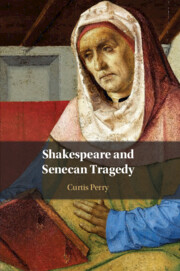Book contents
- Shakespeare and Senecan Tragedy
- Shakespeare and Senecan Tragedy
- Copyright page
- Contents
- Acknowledgments
- Note on Texts
- Chapter 1 Shakespeare and the Resources of Senecan Tragedy
- Chapter 2 Richard III as Senecan History
- Chapter 3 Seneca and the Modernity of Hamlet
- Chapter 4 Seneca and the Antisocial in King Lear
- Chapter 5 Republican Coriolanus and Imperial Seneca
- Chapter 6 Seneca, Titus, and Imperial Globalization
- Chapter 7 Senecan Othello and the Republic of Venice
- Bibliography
- Index
Chapter 5 - Republican Coriolanus and Imperial Seneca
Published online by Cambridge University Press: 06 October 2020
- Shakespeare and Senecan Tragedy
- Shakespeare and Senecan Tragedy
- Copyright page
- Contents
- Acknowledgments
- Note on Texts
- Chapter 1 Shakespeare and the Resources of Senecan Tragedy
- Chapter 2 Richard III as Senecan History
- Chapter 3 Seneca and the Modernity of Hamlet
- Chapter 4 Seneca and the Antisocial in King Lear
- Chapter 5 Republican Coriolanus and Imperial Seneca
- Chapter 6 Seneca, Titus, and Imperial Globalization
- Chapter 7 Senecan Othello and the Republic of Venice
- Bibliography
- Index
Summary
Senecan tragedy is also imperial in that it often locates its characters in relation to the disorientation of global empire. Hercules Furens places its hero’s violent madness at the very moment of world conquest, for instance, and Medea, which features a very famous choral ode about how sea-voyaging rewrites the world, is about the global reach of Roman ambition and desire. Several of Seneca’s philosophical writings (and especially his De Consolatione ad Helviam) likewise examine the tension between stoic self-command and the expansive restlessness of imperial desire. This chapter reads Titus Andronicus as a Senecan exploration of a late-imperial Roman moment in which the Roman scepter commands the whole world and in which racially heterogeneous people and competing modes of imaging civic life are all uneasily incorporated at once. It understands Senecan tragedy as a literary resource for imagining the resulting disorientation. The last section of the chapter examines Titus together with George Peele’s The Battle of Alcazar, and argues that Senecan tragedy provides a model of psychological interiority that is paired with blackface to create the emergent stage stereotype of the wicked Moor.
- Type
- Chapter
- Information
- Shakespeare and Senecan Tragedy , pp. 152 - 186Publisher: Cambridge University PressPrint publication year: 2020

